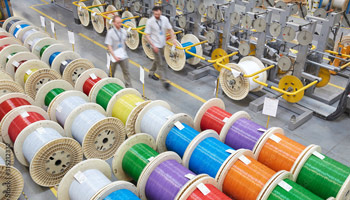Labels for Safety, Visuals and Facility ID Desktop Printers
Labels for Product, Wire and Lab ID Benchtop Printers
Labels for Safety, Visuals and Facility ID Desktop Printers
Labels for Product, Wire and Lab ID Benchtop Printers
Safety and Facility ID Desktop Printers
Product, Wire and Lab ID Benchtop Printers
Barcode Scanner and Printer Kits
Barcode Scanner and Printer Kits
PaintStripe Floor Marking Stencils
Valve Lockouts & Hose Lockouts
Group Lock Boxes & Permit Control
Brady Safety Lockout Tagout Services
Pipe Marker Accessories & Mounting Brackets
Maintenance and Production Tags
Calculators and Assessment Tools
Product Finders and Data Sheets
Fiber optic cables are thin, flexible strands of glass or plastic used in telecommunications, data transmission and other applications where high-speed, high-bandwidth data transfer is required.
In complex network infrastructures, engineers and technicians rely on color coding as an integral part of cable identification. Color codes provide quick visual identification, making it easier to track and manage multiple cables at a time. Use this guide to understand the basics of color coding and why it's important to adhere to certain standards.

Fiber optic cables are color-coded to identify their type, core size and cladding material. Adhering to standardized color codes ensures compliance with industry regulations and best practices, making it easier to track and manage multiple cables in a complex network infrastructure. A standardized color-coding scheme also enables seamless integration and compatibility across different manufacturers and cable types.
There are several different fiber color code standards for fiber optic cables, so it’s important to choose the one that is most appropriate for your application. The most common standards are TIA-598C, ANSI/TIA-568.3-D, ISO/IEC 11801 and ITU-T G.652.

Based on the TIA-598 color code standard, the following colors are commonly used to determine the fiber classifications, fiber numbers and sizes of cables used.
The outer jacket of a fiber optic cable is color coded to indicate the cable type.
Within a multi-fiber cable, individual fibers adhere to a specific fiber optic cable color code. Each fiber is typically distinguished by color-coded jackets, buffers or tubes. As outlined in TIA-598, inner fibers are grouped into sets of 12 and numbered in a clockwise direction.
When a cable has more than 12 fiber strands (like a 24-fiber cable), the color code repeats. However, each 12-strand group should be identified in a unique way. For example, in a 24-strand cable, a stripe could be added to the second group to distinguish the new group from the previous one. The standard 12-color sequence is as follows:
| Fiber Number | Color | |
|---|---|---|
| 1 | Blue | |
| 2 | Orange | |
| 3 | Green | |
| 4 | Brown | |
| 5 | Grey | |
| 6 | White | |
| 7 | Red | |
| 8 | Black | |
| 9 | Yellow | |
| 10 | Violet | |
| 11 | Rose | |
| 12 | Aqua | |
Color codes are also used to identify the type of connector used on a fiber optic patch cord.
Note that it's essential to distinguish between UPC and APC connectors as they cannot be mixed.
While the TIA-598C standard is widely accepted and used in North America, other countries and regions may have their own color-coding standards for fiber optic cables. Some of the most common international variations include:
When working in a global environment, it’s important to be aware of different international standards to ensure that cables are properly identified, and that there’s no confusion or miscommunication. See how Brady can help reduce confusion with our wire and cable labels.

Fiber optic color coding is used in a variety of applications to identify and manage different types of fiber optic cables and connectors.
Overall, color codes in fiber optic cables are essential for identification, installation, troubleshooting, safety, standards compliance, efficiency and universal understanding. They play a vital role in ensuring the reliability, performance, and longevity of fiber optic networks. By understanding different standards and color code charts, you can make your job easier and more efficient.

Just like selecting the right fiber optic cable, we’re here to help you choose the perfect label printer for your fiber optic applications.
Improve efficiencies with our Cable Label Printers
Streamline wire, cable, and component labeling, including circuit boards, with a label printer applicator.
Increase productivity with the Wraptor A6500
Cable labels are crucial for organizing wires, Ethernet, and voice/data lines, making it easy to identify connections during troubleshooting and future installs.
Durable Cable Labels for Fiber Optic
Your guide to server rack, ethernet & patch panel cable organization.
Learn Best Practices for Cable Management
Get real value from choosing the right cable and wire labels & label printer
Choose The Right Cable Label
Behind outlets and switch plates is a network of colorful wires—red, black, yellow, and green—designed to connect and ensure safety.
Explore the Benefits of Wire Color Coding